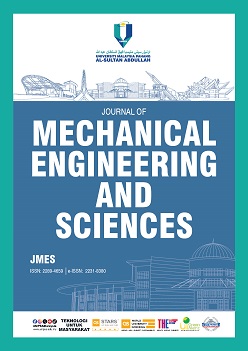Finite element analysis of hip implant using additive manufacturing materials in different loading conditions
DOI:
https://doi.org/10.15282/jmes.19.2.2025.6.0834Keywords:
Finite Element Analysis (FEA), Additive Manufacturing, Hip Implant, Biocompatibility, Total hip replacementAbstract
A hip implant is a crucial medical device designed to restore mobility and relieve pain for an individual with a hip joint with degenerative diseases or injury. Conventional manufacturing techniques have limitations in producing personalized implants. In contrast, additive manufacturing (AM) offers a solution by enabling the production of hip implants using biocompatible materials, such as Ti-alloy, CoCr-alloy, and Mg-alloy. Ti alloys are used for their superior biocompatibility and mechanical performance. This study aims to utilize a computer-aided design file in finite element analysis (FEA) to predict implant stress distribution, deformation, and potential biomechanical performance. The methodology includes designing the hip implant with CAD software and using Ansys to assess the mechanical performance of hip implants using Ti-6Al-4V, an AM material, at four different loading conditions. The results indicate that the total deformation at four different loadings is as follows: sitting, 0.15%; standing, 0.17 mm; walking, 0.21%; and jogging, 0.33%. The equivalent von Mises stresses of the hip implant while sitting: 288.83 MPa, standing: 339.8 MPa, walking: 423.73 MPa, and jogging: 650.93 MPa. Additional analysis of shear stresses for the hip implant while sitting: 59.738 MPa, standing: 70.28 MPa, walking: 84.556 MPa, and jogging: 134.630 MPa. Based on the result, maximum deformation, equivalent stress, and shear stress are predicted to be highest while jogging compared to other activities due to the highest load acting on the hip implant, and equivalent stresses are less than the material’s yield strength and similarly shear stresses are less than the material’s shear strength that indicates the design is safe under physiological loadings. In conclusion, this study successfully implemented the FEA of hip implants using AM materials to achieve potential mechanical performance. The integration of AM and FEA holds promise for the future of modern hip replacement surgery.
References
[1] T. Kermavnar, A. Shannon, K. J. O’Sullivan, C. McCarthy, C. P. Dunne, L. W. O’Sullivan, “Three-dimensional printing of medical devices used directly to treat patients: A systematic review,” 3D Printing and Additive Manufacturing, vol. 8, pp. 366–408, 2021.
[2] M. E. Shehata, K. B. Mustapha, E. M. Shehata, “Finite element and multivariate random forests modelling for stress shield attenuation in customized hip implants,” Forces in Mechanics, vol. 10, p. 100151, 2023.
[3] A. A. Noman, M. S. Shaari, H. Mehboob, A. H. Azman, “Recent advancements in additively manufactured hip implant design using topology optimization technique,” Results in Engineering, vol. 25, p. 103932, 2025.
[4] T. D. Ngo, A. Kashani, G. Imbalzano, K. T. Q. Nguyen, D. Hui, “Additive manufacturing (3D printing): A review of materials, methods, applications and challenges,” Composites Part B: Engineering, vol. 143, pp. 172–196, 2018.
[5] S. M. Fijul Kabir, K. Mathur, A. Fattah M. Seyam, “A critical review on 3D printed continuous fiber-reinforced composites: History, mechanism, materials and properties,” Composite Structures, vol. 232, pp. 1–24, 2020.
[6] S. P. Tan, M. A. Ramlan, M. S. Shaari, A. Takahashi, M. R. M. Akramin, “Microstructural and mechanical characterization of AlSi10Mg additively manufactured material using direct metal laser sintering technique,” in Technological Advancement in Mechanical and Automotive Engineering, pp. 349–360, 2023.
[7] M. Touri, F. Kabirian, M. Saadati, S. Ramakrishna, M. Mozafari, “Additive manufacturing of biomaterials − The evolution of rapid prototyping,” Advanced Engineering Materials, vol. 21, p.1800511, 2019.
[8] N. Vidakis, C. David, M. Petousis, D. Sagris, N. Mountakis, A. Moutsopoulou, “The effect of six key process control parameters on the surface roughness, dimensional accuracy, and porosity in material extrusion 3D printing of polylactic acid: prediction models and optimization supported by robust design analysis,” Advances in Industrial and Manufacturing Engineering, vol. 5, p.100104, 2022.
[9] D. Savio, A. Bagno, “When the total hip replacement fails: A review on the stress-shielding effect,” Processes, vol. 10, pp. 1–17, 2022.
[10] A. Bandyopadhyay, I. Mitra, S. B. Goodman, M. Kumar, S. Bose, “Improving biocompatibility for next generation of metallic implants,” Progress in Materials Science, vol. 133, p. 101053, 2023.
[11] L. Guo, S. Ataollah Naghavi, Z. Wang, S. Nath Varma, Z. Han, Z. Yao, et al., “On the design evolution of hip implants: A review,” Materials & Design, vol. 216, p. 110552, 2022.
[12] M. Feyzi, K. Fallahnezhad, M. Taylor, R. Hashemi, “A review on the finite element simulation of fretting wear and corrosion in the taper junction of hip replacement implants,” Computers in Biology and Medicine, vol. 130, p. 104196, 2021.
[13] H. McKellop, I. Clarke, K. Markolf, H. Amstutz, “Friction and wear properties of polymer, metal, and ceramic prosthetic joint materials evaluated on a multichannel screening device,” Journal of Biomedical Materials Research, vol. 15, no. 5, pp. 619–653, 1981.
[14] M. Merola, S. Affatato, “Materials for hip prostheses: A review of wear and loading considerations,” Materials, vol. 12, p.495, 2019.
[15] F. Y. Chin, M. S. Shaari, A. Takahashi, M. R. M. Akramin, S. Urai, “Fatigue crack growth behavior of AlSi10Mg material produced by direct metal laser sintering using s-version finite element method,” Journal of Failure Analysis and Prevention, vol. 23, no. 2, pp. 601–608, 2023.
[16] P. Jhunjhunwala, A. Kishor, R. G. Burela, R. Singh, A. Gupta, “Finite element analysis and topology optimization of Ti-6Al-4V hip implant fabricated by laser powder bed fusion process,” Proceedings of the Institution of Mechanical Engineers, Part E: Journal of Process Mechanical Engineering, p. 09544089221144189, 2022.
[17] T. Lee, S. Lee, I. S. Kim, Y. H. Moon, H. S. Kim, C. H. Park, “Breaking the limit of Young’s modulus in low-cost Ti–Nb–Zr alloy for biomedical implant applications,” Journal of Alloys and Compounds, vol. 828, p. 154401, 2020.
[18] M. A. Azri, M. S. Shaari, A. Kamal Ariffin, S. Abdullah, “Microstructure, mechanical properties and fatigue behavior of AlSi10Mg: an additive manufacturing material,” International Journal of Engineering & Technology, vol. 7, pp. 186–190, 2018.
[19] M. Ceddia, B. Trentadue, G. De Giosa, G. Solarino, “Topology optimization of a femoral stem in titanium and carbon to reduce stress shielding with the FEM method,” Journal of Composites Science, vol. 7, no. 7, 2023.
[20] Z. Yang. Finite Element Analysis for Biomedical Engineering Applications. 1st ed. Boca Raton: CRC Press, 2019.
[21] K. N. Chethan, N. Shyamasunder Bhat, M. Zuber, B. Satish Shenoy, “Static structural analysis of different stem designs used in total hip arthroplasty using finite element method,” Journal of Biomedical Physics and Engineering, vol. 9, no. 5, pp. 507–516, 2019.
[22] P. K. Mishra, B. Karthik, T. Jagadesh, “Finite element modelling and experimental investigation of tensile, flexural, and impact behaviour of 3D-printed polyamide,” Journal of The Institution of Engineers (India): Series D, vol. 105, no. 1, pp. 275–283, 2024.
[23] R. Rahchamani, R. Soheilifard, “Three-dimensional structural optimization of a cementless hip stem using a bi-directional evolutionary method,” Computer Methods in Biomechanics and Biomedical Engineering, vol. 23, no. 1, pp. 1–11, 2020.
[24] F. Eltit, Q. Wang, R. Wang, “Mechanisms of adverse local tissue reactions to hip implants,” Frontiers in Bioengineering and Biotechnology, vol. 7, no. 176, pp. 1–17, 2019.
[25] C. K N, G. Ogulcan, S. Bhat N, M. Zuber, S. Shenoy B, “Wear estimation of trapezoidal and circular shaped hip implants along with varying taper trunnion radiuses using finite element method,” Computer Methods and Programs in Biomedicine, vol. 196, p. 105597, 2020.
[26] C. X. Wei, M. F. Burrow, M. G. Botelho, H. Lam, W. K. Leung, “In vitro salivary protein adsorption profile on titanium and ceramic surfaces and the corresponding putative immunological implications,” International Journal of Molecular Sciences, vol. 21, no. 9, pp. 1–17, 2020.
[27] A. H. Chern, P. Nandwana, T. Yuan, M. M. Kirka, R. R. Dehoff, P. K. Liaw, et al., “A review on the fatigue behavior of Ti-6Al-4V fabricated by electron beam melting additive manufacturing,” International Journal of Fatigue, vol. 119, no. May, pp. 173–184, 2019.
[28] A. E. Ismail, A. K. Ariffin, S. Abdullah, M. J. Ghazali, “Finite element analysis of j-integral for surface cracks in round bars under combined mode I loading,” International Journal of Integrated Engineering, vol. 9, no. 2, 2017.
[29] M. R. M. Akramin, A. K. Ariffin, M. Kikuchi, M. Beer, M. S. Shaari, M. N. M. Husnain, “Surface crack growth prediction under fatigue load using probabilistic S-version finite element model,” Journal of the Brazilian Society of Mechanical Sciences and Engineering, vol. 40, no. 11, p. 522, 2018.
[30] O. M. Al-Moayed, A. K. Kareem, A. E. Ismail, S. Jamian, M. N. Nemah, “Distribution of mode I stress intensity factors for single circumferential semi-elliptical crack in thick cylinder,” International Journal of Integrated Engineering, vol. 11, no. 7, pp. 102–111, 2019.
[31] M. S. Shaari, A. K. Ariffin, A. Takahashi, S. Abdullah, M. Kikuchi, M. R. M. Akramin, “Fatigue crack growth analysis on square prismatic with embedded cracks under tension loading,” Journal of Mechanical Engineering and Sciences, vol. 14, no. 1, pp. 2511–2525, 2017.
[32] K. N. Chethan, M. Zuber, B. N. Shyamasunder, S. B. Satish, “Optimized trapezoidal-shaped hip implant for total hip arthroplasty using finite element analysis,” Cogent Engineering, vol. 7, no. 1, p. 1719575, 2020.
[33] N. Premkumar, K. Subhashini, G. Valarmathi, J. Kumar, S. Meganathan, ‘‘Numerical analysis of hip bone replacement design parameters’’, Materials Today: Proceedings, vol. 46, pp. 4271–4277, 2020.
[34] E. Tyflopoulos, M. Steinert, “A comparative study of the application of different commercial software for topology optimization,” Applied Sciences (Switzerland), vol. 12, no. 2, p. 611, 2022.
[35] S. A. Naghavi, M. Tamaddon, P. Garcia-Souto, M. Moazen, S. Taylor, J. Hua, et al., “A novel hybrid design and modelling of a customised graded Ti-6Al-4V porous hip implant to reduce stress-shielding: An experimental and numerical analysis”, Frontiers in Bioengineering and Biotechnology, vol. 11, no. 1, pp. 1–20, 2023.
[36] G. Bergmann, A. Bender, J. Dymke, G. Duda, P. Damm, “Standardized loads acting in hip implants,” PLOS ONE, vol. 11, no. 5, p. e0155612, 2016.
Downloads
Published
Issue
Section
License
Copyright (c) 2025 The Author(s)

This work is licensed under a Creative Commons Attribution-NonCommercial 4.0 International License.






